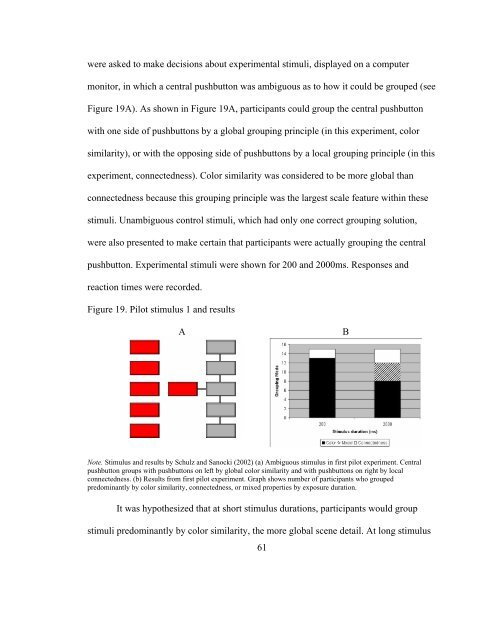The Use of Iambic Pentameter in the
The Use of Iambic Pentameter in the
The Use of Iambic Pentameter in the
You also want an ePaper? Increase the reach of your titles
YUMPU automatically turns print PDFs into web optimized ePapers that Google loves.
were asked to make decisions about experimental stimuli, displayed on a computer<br />
monitor, <strong>in</strong> which a central pushbutton was ambiguous as to how it could be grouped (see<br />
Figure 19A). As shown <strong>in</strong> Figure 19A, participants could group <strong>the</strong> central pushbutton<br />
with one side <strong>of</strong> pushbuttons by a global group<strong>in</strong>g pr<strong>in</strong>ciple (<strong>in</strong> this experiment, color<br />
similarity), or with <strong>the</strong> oppos<strong>in</strong>g side <strong>of</strong> pushbuttons by a local group<strong>in</strong>g pr<strong>in</strong>ciple (<strong>in</strong> this<br />
experiment, connectedness). Color similarity was considered to be more global than<br />
connectedness because this group<strong>in</strong>g pr<strong>in</strong>ciple was <strong>the</strong> largest scale feature with<strong>in</strong> <strong>the</strong>se<br />
stimuli. Unambiguous control stimuli, which had only one correct group<strong>in</strong>g solution,<br />
were also presented to make certa<strong>in</strong> that participants were actually group<strong>in</strong>g <strong>the</strong> central<br />
pushbutton. Experimental stimuli were shown for 200 and 2000ms. Responses and<br />
reaction times were recorded.<br />
Figure 19. Pilot stimulus 1 and results<br />
A<br />
Note. Stimulus and results by Schulz and Sanocki (2002) (a) Ambiguous stimulus <strong>in</strong> first pilot experiment. Central<br />
pushbutton groups with pushbuttons on left by global color similarity and with pushbuttons on right by local<br />
connectedness. (b) Results from first pilot experiment. Graph shows number <strong>of</strong> participants who grouped<br />
predom<strong>in</strong>antly by color similarity, connectedness, or mixed properties by exposure duration.<br />
It was hypo<strong>the</strong>sized that at short stimulus durations, participants would group<br />
stimuli predom<strong>in</strong>antly by color similarity, <strong>the</strong> more global scene detail. At long stimulus<br />
61<br />
B

















